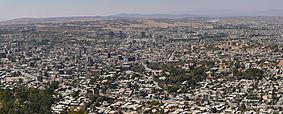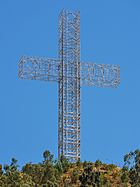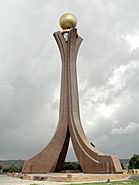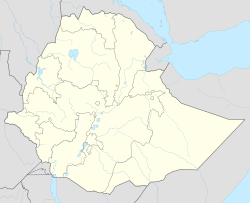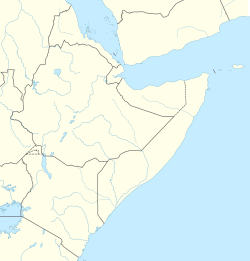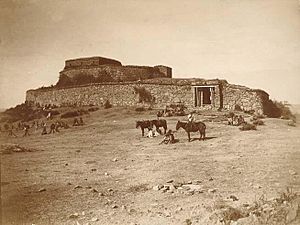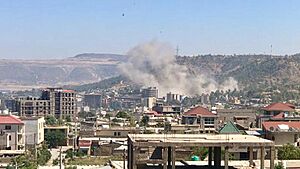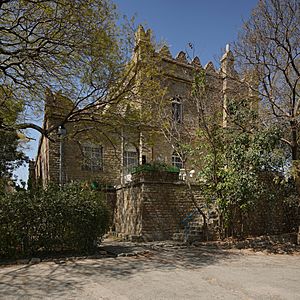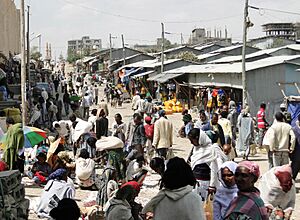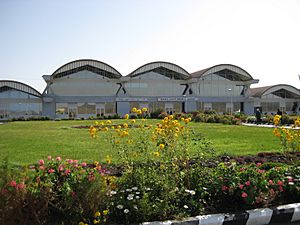Mekelle facts for kids
Quick facts for kids
Mekelle
መቐለ
ሰሜናዊት ኮኾብ Mak'allè, Mekele, mäqälle, mek’elē
|
|
|---|---|
|
Capital city and special zone
|
|
|
From top, left to right: Central Mekelle; Hawzen Square; Tekele Haymanot Church; Emperor Yohannes IV Palace Museum; Meskel cross at Chom’a hill; Martyrs' Memorial Monument
|
|
| Nickname(s):
The Northern Star(ሰሜናዊት ኮኾብ)
|
|

Mekelle special zone
|
|
| Country | |
| Region | Tigray |
| Zone | Mekelle Special Zone |
| Elevation | 2,254 m (7,395 ft) |
| Population
(2023)
|
|
| • Total | 525,475 |
| • Estimate
(2023)
|
545,635 |
| Time zone | UTC+3 (EAT) |
| Area code(s) | (+251) 14 |
| Climate | Hot semi-arid |
Mekelle (Tigrinya: መቐለ), also called Mek'ele, is a very important city in Ethiopia. It is the capital of the Tigray Region and is considered a special zone. This means it has its own unique way of being governed. Mekelle is about 780 kilometers (485 miles) north of Addis Ababa, the capital of Ethiopia. It sits high up, about 2,254 meters (7,395 feet) above sea level.
Mekelle is divided into seven smaller areas called sub-cities. It is the main center for business, culture, and politics in northern Ethiopia. The city has grown a lot, from about 61,000 people in 1984 to over 545,000 people today. This makes it the second-largest city in Ethiopia, after Addis Ababa. Most people in Mekelle work for the government, in shops, or in small businesses. The city also has factories for engineering, cement, and textiles. Mekelle University and many other colleges are also located here.
Contents
History of Mekelle
How Mekelle Started
Mekelle began as a small village called Enda Meseqel around the 13th century. It grew into a town by the early 1800s. A local leader, ras Wolde Selassie, used the area as a fun place to visit. Later, in the tax records of Emperor Tewodros II, Mekelle was listed as a district that paid taxes.
Mekelle in the 1800s
Mekelle became a major city thanks to Emperor Yohannes IV. He made Mekelle the political capital of his growing empire. He likely chose it because it was close to rich farming areas and the salt-producing region. It was also on the road to Shewa, where his rival Menelik II lived.
Emperor Yohannes IV built three important things in Mekelle:
- A grand palace, built between 1882 and 1884. This palace is still the historic center of Mekelle.
- A large market called Edaga Senuy (meaning "Monday Market").
- A church called Debre Gennet Medhane Alem.
In the 1880s, Mekelle was even the capital city of Ethiopia. Many noble families and traders moved there. Its location made it a key stop for trade routes connecting to the Red Sea and other parts of Ethiopia. Emperor Yohannes used his power to bring trade and salt caravans to the town.
When Emperor Menelik II took over, trade shifted more towards southern Ethiopia and the new capital, Addis Ababa. However, Mekelle still remained important. It was a center for local and regional government and continued to play a role in Ethiopia's salt trade.
During the war with Italy in 1895–96, Mekelle became a battleground. Italian forces occupied the city. They built a fort near the Enda Eyesus church. Ethiopian troops surrounded the fort and cut off their water supply. The Italians surrendered, and Emperor Menelik allowed them to leave.
Mekelle in the 1900s
Mekelle continued to grow in the 20th century. A governor named dejazmach Abreha Araya Demtsu built his own palace, a new Saturday Market, and a new church. This attracted more people, including traders and soldiers.
When Italy occupied Mekelle from 1935 to 1941, they modernized the city a lot. They built an airport, improved roads, and added telephone lines, electricity, and clinics. They also expanded the market. Mekelle became twice its original size during this time.
In the 1940s, Mekelle saw more changes. A city government was created in 1942. New offices, banks, and schools were built. Small factories for things like soap and flour also started. However, many of these factories closed during the Ethiopian Civil War (1974-1991).
During a severe food shortage in Ethiopia in the 1980s, Mekelle had several "hunger camps" for people seeking help. In 1986, a group called the Tigray People's Liberation Front (TPLF) freed many political prisoners from Mekelle prison. Later, in 1989, the TPLF took control of Mekelle. Towards the end of the civil war, the city was bombed, and many people died.
In 1998, during the Eritrean–Ethiopian War, the Eritrean Air Force bombed Ayder School in Mekelle, killing twelve people. A monument in the city remembers this sad event.
Mekelle in the 2000s
In 2002, there was a disagreement between different religious groups in Mekelle, which led to some clashes. Police had to step in to stop the fighting.
From 2000 to 2008, the United Nations Mission in Ethiopia and Eritrea (UNMEE) had its main office in Mekelle. This was after the war between Eritrea and Ethiopia ended.
More recently, during the Tigray War, Mekelle faced attacks and bombings. In late 2020, Ethiopian and Eritrean forces entered Mekelle. There were reports of looting and a lack of law and order. Many people were affected by the fighting. In June 2021, the Tigray Defense Forces recaptured Mekelle.
Geography
Mekelle is located on a high plateau made of limestone. It's in a semi-dry area, meaning it doesn't get a lot of rain, but enough to support some plant life. The average rainfall is about 714 millimeters (28 inches) per year. The landscape around Mekelle is mostly treeless, except for some eucalyptus trees on the hills and other trees along the streets.
Cityscape and Landmarks
One important landmark is the Martyrs' Memorial Monument. It is 51 meters (167 feet) tall and honors the many TPLF fighters who died or were injured during the overthrow of the previous government in 1991. The monument has sculptures showing the struggle of the people.
Emperor Yohannes IV built a castle and churches in Mekelle in the 19th century. The castle was designed by Ethiopian and Italian engineers. Today, this castle is a museum. You can see the Emperor's throne, royal bed, clothes, and old rifles there.
Other important churches in Mekelle include Enda Gabir, Enda Yesus Mekelle Bete Mengist, and Mekelle Tekle Haymanot.
Sub-cities
Mekelle is divided into seven main areas called sub-cities: Hawelti, Adi-Haki, Kedamay Weyane, Hadnet, Ayder, Semien, and Quiha. Each sub-city has its own leader who helps manage local development, health, education, and utilities.
The central sub-cities – Kedamay Weyane, Ayder, and Hawelti – are the main business areas. Semien is known for its many factories and is often called the "economic center" of Tigray.
Climate
Mekelle has a climate that is mostly warm all year. It has clear wet and dry seasons. The climate is considered cool semi-arid, but it is also close to a subtropical highland climate and a hot semi-arid climate.
| Climate data for Mekelle, elevation 2,070 m (6,790 ft), (1971–2000) | |||||||||||||
|---|---|---|---|---|---|---|---|---|---|---|---|---|---|
| Month | Jan | Feb | Mar | Apr | May | Jun | Jul | Aug | Sep | Oct | Nov | Dec | Year |
| Mean daily maximum °C (°F) | 23.7 (74.7) |
25.0 (77.0) |
26.0 (78.8) |
26.2 (79.2) |
26.2 (79.2) |
27.1 (80.8) |
23.9 (75.0) |
23.2 (73.8) |
25.1 (77.2) |
24.4 (75.9) |
23.3 (73.9) |
22.6 (72.7) |
24.7 (76.5) |
| Mean daily minimum °C (°F) | 7.4 (45.3) |
7.6 (45.7) |
10.4 (50.7) |
12.3 (54.1) |
12.3 (54.1) |
12.3 (54.1) |
12.3 (54.1) |
12.3 (54.1) |
10.9 (51.6) |
10.7 (51.3) |
9.0 (48.2) |
7.0 (44.6) |
10.4 (50.7) |
| Average precipitation mm (inches) | 2.0 (0.08) |
6.0 (0.24) |
21.0 (0.83) |
40.0 (1.57) |
31.0 (1.22) |
38.0 (1.50) |
209.0 (8.23) |
225.0 (8.86) |
38.0 (1.50) |
3.0 (0.12) |
6.0 (0.24) |
1.0 (0.04) |
620 (24.43) |
| Average relative humidity (%) | 54 | 52 | 51 | 49 | 44 | 46 | 73 | 77 | 59 | 50 | 53 | 55 | 55 |
| Source: FAO | |||||||||||||
People of Mekelle
Ethnic groups of Mekelle in 1994 Tigrayan (96.5%) Amhara (1.59%) Eritreans (0.99%) Other (0.92%)
In 1935, Mekelle had about 5,000 people. By 1938, it grew to about 12,000. According to a 2007 census, Mekelle had 215,914 people. Most people (96.2%) are from the Tigray ethnic group. The main language spoken is Tigrinya (95.55%). Most residents (92.68%) are Orthodox Christians, and 6.03% are Muslim.
In 1994, the census showed that 91.11% of children aged 7–12 were in primary school. Many houses had access to safe drinking water and toilet facilities.
Economy
Mekelle is a major economic and educational center in Ethiopia.
Factories and Industry
Mekelle has important factories. Mesfin Industrial Engineering makes steel and assembles cars. Messebo Cement Factory is a big cement producer for northern Ethiopia. Both companies are owned by a group called the Endowment Fund for the Rehabilitation of Tigray (EFFORT).
The Mekelle Industrial Park is a large area with many foreign textile companies. It provides jobs for about 20,000 people.
Services
The city has seen a big increase in hotels for tourists and conferences. Healthcare services have also improved, helping the people of Mekelle. A modern health laboratory was built to help train medical staff and ensure good quality in hospitals.
Farming and Livestock
Mekelle is surrounded by farming villages. These villages sell their crops to the city residents in the markets. There are traditional markets on Saturdays and Mondays where you can buy fresh produce, livestock, and salt from the Afar region. There is also a slaughterhouse that started operations in 2008.
Getting Around and Education
Transportation
Mekelle has good roads connecting it to Addis Ababa and Aksum. It also has an airport called Ras Alula Aba Nega International Airport. You can travel between cities by bus, and there are local buses for getting around Mekelle.
A new electric railway, the Weldiya–Mekelle Railway, is being built. It will connect Mekelle to Addis Ababa and Djibouti, making travel and trade easier. The railway will end in Qwiha, one of Mekelle's sub-cities.
Education
Mekelle has many schools, from kindergartens to high schools. These are run by local government offices. There are also many private schools.
The city is home to several universities and colleges. Some of Ethiopia's well-known universities, like Mekelle University and Mekelle Institute of Technology, are located here.
Sports
Mekelle has its own football (soccer) teams, including Mekelle 70 Enderta F.C. and Dedebit F.C.. These teams play in the Ethiopian Premier League.
International Connections
Mekelle is part of the Millennium Cities Initiative, which helps cities in developing countries grow.
Sister Cities
Mekelle has special partnerships with other cities around the world, called "sister cities":
 Ramla, Israel
Ramla, Israel Witten, Germany
Witten, Germany
See also
 In Spanish: Mekele para niños
In Spanish: Mekele para niños


